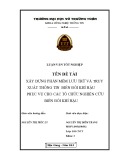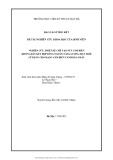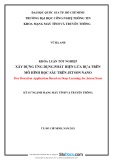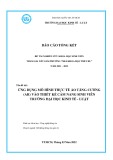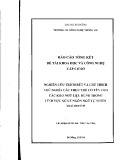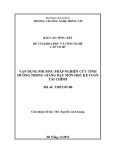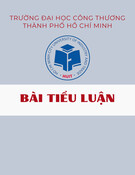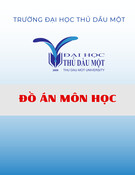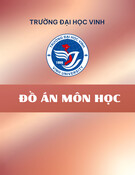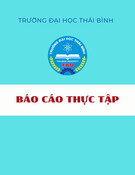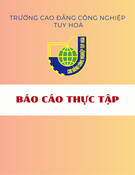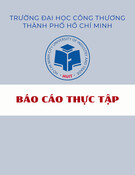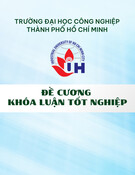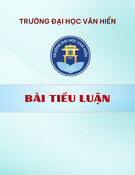
ĐẠI HỌC ĐÀ NẴNG
TRƯỜNG CĐ CÔNG NGHỆ THÔNG TIN
BÁO CÁO TỔNG KẾT
ĐỀ TÀI KHOA HỌC VÀ CÔNG NGHỆ
CẤP CƠ SỞ
XÂY DỰNG HỆ THỐNG QUẢN LÝ PHÒNG MÁY
THỰC HÀNH TẠI TRƯỜNG CĐ CNTT
Mã số: T2017-07-09
Chủ nhiệm đề tài: Th.S Phan Trọng Thanh
Thành viên tham gia: ThS. Nguyễn Anh Tuấn
Đà Nẵng, 12/2017

ĐẠI HỌC ĐÀ NẴNG
TRƯỜNG CĐ CÔNG NGHỆ THÔNG TIN
BÁO CÁO TỔNG KẾT
ĐỀ TÀI KHOA HỌC VÀ CÔNG NGHỆ
CẤP CƠ SỞ
XÂY DỰNG HỆ THỐNG QUẢN LÝ PHÒNG MÁY
THỰC HÀNH TẠI TRƯỜNG CĐ CNTT
Mã số: T2017-07-09
Xác nhận của cơ quan chủ trì đề tài Chủ nhiệm đề tài
Phan Trọng Thanh
Đà Nẵng, 12/2017

TABLE OF CONTENTS
LIST OF FIGURES ................................................................................................ i
LIST OF TABLES ................................................................................................ ii
LIST OF ABBREVIATIONS .............................................................................. iii
THÔNG TIN KẾT QUẢ NGHIÊN CỨU ............................................................ iv
INTRODUCTION ................................................................................................. 1
1. Reasons .......................................................................................................... 1
2. Research objectives and tasks ....................................................................... 2
3. Research subjects ........................................................................................... 2
4. Layout ............................................................................................................ 2
CHAPTER 1. RELATED WORK ........................................................................ 3
1.1. Integrated Module ...................................................................................... 3
1.2. Software ...................................................................................................... 4
1.3. Discussion ................................................................................................... 5
CHAPTER 2. DESIGN AND BUILD THE SYSTEM ........................................ 6
2.1. Survey the system ....................................................................................... 6
2.2. Build functions ........................................................................................... 7
2.2.1. System Management ............................................................................ 7
2.2.2. Category Management ......................................................................... 8
2.2.3. Manage the operation of the equipment .............................................. 8
2.2.4. Manage your practice calendar registration......................................... 8
2.2.5. Message Management ......................................................................... 8
2.2.6. Statistics - reports ................................................................................ 8
2.5. Some demo system figures ......................................................................... 9
CHAPTER 3. EXPERIMENTAL, SURVEY AND EVALUATION ................ 11
3.1. Purposes of studying ................................................................................. 11
3.2. Technology acceptance model (TAM) ..................................................... 11
3.2.1. Perceived usefulness (PU) ................................................................. 12
3.2.2. Perceived ease to use (PEU) .............................................................. 13

3.2.3. Attitude toward using (ATU) ............................................................ 13
3.2.4. Behavioral intention to use (BI) ........................................................ 14
3.3. Conceptual model ..................................................................................... 14
3.4. Research Hypotheses ................................................................................ 15
3.5. Operational Definition .............................................................................. 16
3.6. Questionnaire Design ............................................................................... 17
CHAPTER 4. CONCLUSION ............................................................................ 22
4.1. The results of the thesis ............................................................................ 22
4.2. Existence, weakness ................................................................................. 22
4.3. Future development .................................................................................. 22
REFERENCES .................................................................................................... 23

i
LIST OF FIGURES
Fig 1. The borrowings - check out the lab, lecturers have to write on papers ...... 1
Fig 1.1. Screenshots of tmProx ............................................................................. 3
Fig 1.2. Screenshots of iTALC demonstrating the work with it ........................... 4
Fig 1.3. Screenshots of iTALC demonstrating the work with it ........................... 5
Fig 2.1. Demonstration of laboratory equipment management ............................ 9
Fig 2.2. Demonstration of equipment scheduling functionality ......................... 10
Fig 3.1. Conceptual model of the survey ............................................................ 15
Fig 3.2. Structural model ..................................................................................... 18

